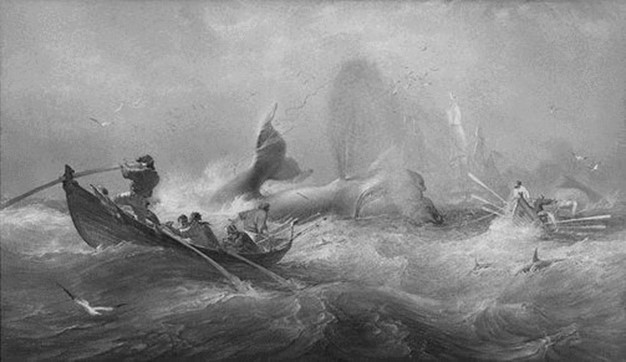South Coast NSW History Story
Whaling
Whaling in Twofold Bay
For a century, from 1828 to 1929, whaling in Twofold Bay was a significant industry.
Whaling in Australia had become a financially attractive proposition from 1823 when heavy duties in Britain on colonial oils (e.g. whale oil) were removed – actually resulting, a decade later, in whale products briefly becoming the largest grossing Australian export!
And Twofold Bay was ‘tailor made’ for the exploitation of this commercial opportunity – the Bay provided good shelter to ships, whales were abundantly available and came in close to the shore on their annual migrations, and a method of easy harvest had already been established by the local Yuin Indigenous people.
A unique, mutually beneficial relationship had been forged over centuries in Twofold Bay between the Yuin people and pods of orcas (or ‘Killer Whales’ – although they are not whales but oceanic dolphins). The orcas would regularly herd passing whales into the Bay, resulting in those whales beaching themselves and thereby providing welcome food to the Yuin. The orcas were rewarded by the Indigenes with the tongues and lips (which weighed many tons) from these whales. The Yuin were alerted to the presence of whales in the Bay by the orcas breaching and ‘flop-tailing’ (slapping their tails on the surface of the water); and the Yuin would also ‘call’ the orcas by water-slapping and by chanting.
In 1828 Thomas Raine, a mariner and merchant, established the first shore-based whaling station on the Australian mainland on the shores of Twofold Bay. The Imlay brothers and Ben Boyd followed in the 1830s and 1840s, also setting up whaling enterprises in the Bay.
From 1857 Alexander Davidson, who had been a cabinet maker for Benjamin Boyd, settled in the area and established the best-known and longest-surviving Twofold Bay whaling enterprise. He did so by purchasing heavily-discounted whaling equipment left behind by Benjamin Boyd after his financial empire collapsed in the late 1840s.
Davidson rebuilt an old whaling station at the mouth of the Kiah River, adding boatsheds and tryworks (furnaces used for heating the blubber from whales to recover the whale oil) that allowed the catch to be hauled up the beach for processing.
Indigenous whalers became a vital and valued part of Davidson’s workforce. Through a friendly and lengthy association with the local Aboriginal people, the Davidsons developed the same mutually-beneficial relationship with the pods of orcas as the Yuin people had enjoyed. When whaling was at its peak, up to 30 whaling boats operated in the area and the Davidsons were reportedly the only ones who would be alerted by the orcas of the presence of whales.
In the early years of the twentieth century, 10 to 15 whales were caught each year and processed through the Davidson’s whaling station.
21 male members of the Davidson clan, spanning four generations, were involved in Twofold Bay whaling until 1929. By that time, however, demand for whale products had declined significantly, with alternatives to whale products having been developed. But the number of whales in the area had also declined dramatically, with just one or two whales being caught per year in the final years of the whaling station’s operation.
The Davidson Whaling Station was added to the State Heritage Register in 1999. Artefacts from the once-significant whaling era are scattered around the site. Others are now part of historical displays in the Killer Whale Museum in nearby Eden.
Image: Whaling in Twofold Bay by O.W. Brierly, 1862. Brierly was a marine artist and one time whaling manager for Ben Boyd in Twofold Bay.
